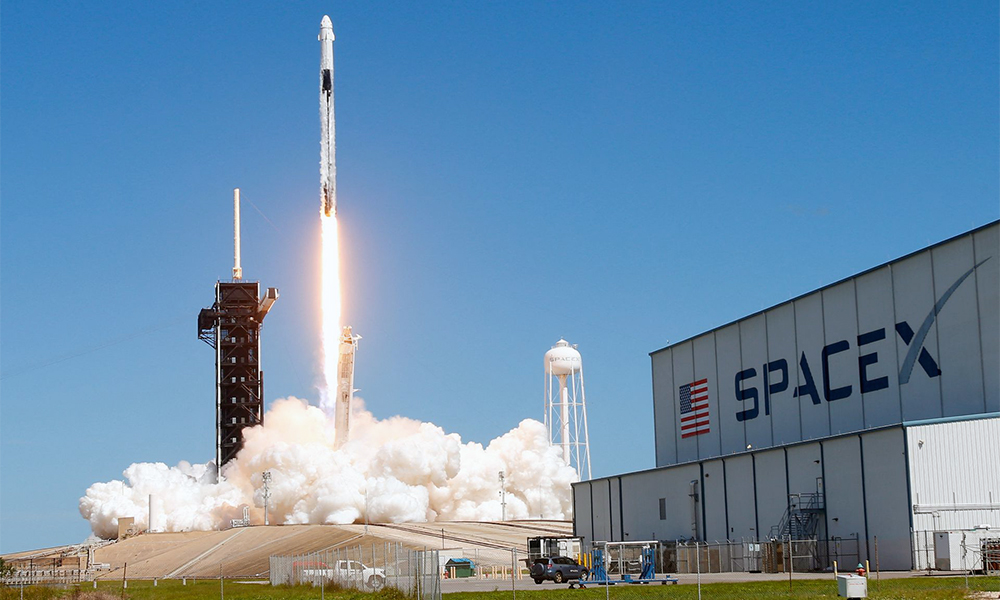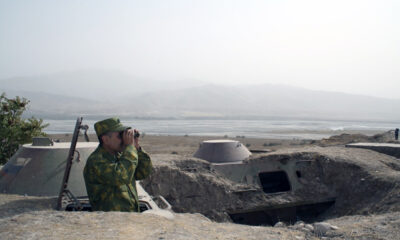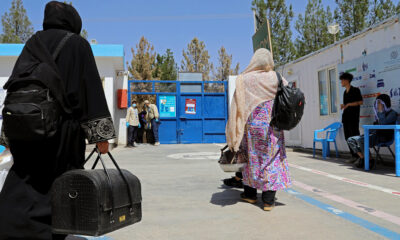Science & Technology
SpaceX capsule heads to space station ferrying NASA crew and Russian

A SpaceX rocket soared into orbit from Florida on Wednesday carrying the next long-term International Space Station crew, with a Russian cosmonaut, two Americans and a Japanese astronaut flying together in a demonstration of U.S.-Russian teamwork in space despite Ukraine war tensions, Reuters reported.
A high-ranking official of the Russian space agency Roscosmos said shortly after the launch that the flight marked “a new phase of our cooperation” with the U.S. space agency NASA.
According to the report the SpaceX launch vehicle, consisting of a Falcon 9 rocket topped with a Crew Dragon capsule dubbed Endurance, lifted off into clear skies at noon EDT (1600 GMT) from NASA’s Kennedy Space Center in Cape Canaveral. The two-stage, 23-story-tall Falcon 9 ascended from the launch tower as its nine Merlin engines roared to life in billowing clouds of vapor and a reddish-orange fireball.
The mission is notable for the inclusion of Anna Kikina, 38, the lone female cosmonaut on active duty with Roscosmos, making it the first spaceflight with a Russian launched from U.S. soil in two decades. As the spacecraft entered Earth orbit, Kikina radioed her thanks to NASA, Roscosmos and their International Space Station (ISS) partners for “giving us this great opportunity.”
“We’re so glad to do it together,” Kikina said.
Kikina, who had trained in the United States for the flight since spring 2021, was essentially swapping places with a NASA astronaut who took her seat aboard a Russian Soyuz flight to the ISS last month under a new ride-sharing deal signed by NASA and Roscosmos in July.
About nine minutes after Wednesday’s launch, the rocket’s upper stage delivered the Crew Dragon into a preliminary orbit as it streaked through space at nearly 16,000 miles per hour (27,000 kph). The reusable lower-stage booster flew itself back to Earth and landed safely on a drone recovery vessel at sea.
The four crew members and their autonomously flying capsule were due to reach the ISS in about 29 hours, on Thursday evening, to begin a 150-day science mission aboard the orbital laboratory some 250 miles (420 km) above Earth, Reuters reported.
The mission, designated Crew-5, marks the fifth full-fledged ISS crew NASA has flown aboard a SpaceX vehicle since the private rocket venture founded by Tesla (TSLA.O) CEO Elon Musk began sending U.S. astronauts aloft in May 2020.
The team was led by Nicole Aunapu Mann, 45, who became the first Native American woman sent to orbit by NASA and the first woman to take the commander’s seat of a SpaceX Crew Dragon.
Moments after reaching orbit, as mission control wished the crew “Godspeed,” Mann radioed back, “Awesome. Thank you so much to the Falcon team. Whew! That was a smooth ride uphill.”
Mann, a U.S. Marine Corps colonel and combat fighter pilot, is also among the first group of 18 astronauts selected for NASA’s upcoming Artemis missions aimed at returning humans to the moon later this decade.
The designated pilot was Mann’s fellow spaceflight rookie Josh Cassada, 49, a U.S. Navy aviator and test pilot with a doctorate in high-energy particle physics. Rounding out the crew from Japan’s space agency JAXA was Koichi Wakata, 59, a robotics expert making his fifth voyage to space.
The team will be welcomed by seven existing ISS occupants – the Crew-4 team consisting of three Americans and an Italian astronaut – as well as two Russians and the NASA astronaut who flew with them to orbit on a Soyuz flight.
The new arrivals are set to conduct more than 200 experiments, many focused on medical research ranging from 3-D “bio-printing” of human tissue to a study of bacteria cultured in microgravity, Reuters reported.
ISS, the length of a football field, has been continuously occupied since 2000, operated by a U.S.-Russian-led consortium that includes Canada, Japan and 11 European countries. It was born in part to improve relations between Washington and Moscow following the Soviet Union’s collapse and the end of Cold War rivalries that spurred the original American-Soviet space race.
NASA-Roscosmos relations have been tested since Russia invaded Ukraine in February and the United States imposed sweeping sanctions against Moscow.
At a post-launch NASA-SpaceX briefing on Wednesday, Sergei Krikalev, head of human spaceflight for Roscosmos, said he agency chief Yuri Borisov were seeking to ease tensions after Borisov’s predecessor, Dmitry Rogozin, raised questions about the future of the ISS partnership.
Krikalev cited bilateral teamwork in space dating back to the Apollo-Soyuz era in 1975, saying, “We started our cooperation many years ago, over 40 years ago, and will continue our cooperation as long as I can imagine.”
The July crew-exchange deal paved the way for resuming routine joint U.S.-Russian flights to the ISS that had begun during the space shuttle era and continued after shuttles ceased flying in 2011. From then until SpaceX began offering crewed launch services nine years later, Soyuz was the only avenue to orbit for U.S. astronauts.
Science & Technology
Ethiopian volcano erupts for first time in nearly 12,000 years
Ash from the eruption drifted across the region, spreading over Yemen, Oman, India, and parts of Pakistan.

The Hayli Gubbi volcano in Ethiopia’s Afar region has erupted for the first time in almost 12,000 years, sending massive ash plumes soaring up to 14 kilometres into the atmosphere, according to the Toulouse Volcanic Ash Advisory Centre.
The eruption began on Sunday and lasted several hours. Hayli Gubbi, located around 800 kilometres northeast of Addis Ababa near the Eritrean border, sits within the geologically active Rift Valley, where two major tectonic plates meet. The volcano rises roughly 500 metres above the surrounding landscape.
Ash from the eruption drifted across the region, spreading over Yemen, Oman, India, and parts of Pakistan. Satellite imagery and social-media videos captured a towering column of white smoke billowing into the sky.
The Smithsonian Institution’s Global Volcanism Program notes that Hayli Gubbi has no recorded eruptions during the Holocene, the period dating back about 12,000 years to the end of the last Ice Age.
Volcanologist Simon Carn of Michigan Technological University also confirmed on Bluesky that the volcano had “no record of Holocene eruptions.”
Science & Technology
Cloudflare outage easing after millions of internet users affected

A global outage at web-infrastructure firm Cloudflare began to ease on Tuesday afternoon after preventing people from accessing major internet platforms, including X and ChatGPT.
Cloudflare, whose network handles around a fifth of web traffic, said it started to investigate the internal service degradation around 6:40 a.m. ET. It has deployed a fix but some customers might still be impacted as it recovers service.
The incident marked the latest hit to major online services. An outage of Amazon’s cloud service last month caused global turmoil as thousands of popular websites and apps, including Snapchat, were inaccessible due to the disruption.
Cloudflare – whose shares were down about 5% in premarket trading – runs one of the world’s largest networks that helps websites and apps load faster and stay online by protecting them from traffic surges and cyberattacks.
The latest outage prevented users from accessing platforms such as Canva, X, and ChatGPT, prompting users to log outage reports with Downdetector.
Downdetector tracks outages by collating status reports from a number of sources. “We saw a spike in unusual traffic to one of Cloudflare’s services beginning at 11:20 UTC. That caused some traffic passing through Cloudflare’s network to experience errors,” the company said in an emailed statement.
“We are all hands on deck to make sure all traffic is served without errors.”
X and ChatGPT-creator OpenAI did not immediately respond to requests for comment. – REUTERS
Science & Technology
China sends its youngest astronaut to ‘Heavenly Palace’ space station

China’s Shenzhou-21 space rocket and its crew including the youngest member of its astronaut corps blasted off on Friday atop a Long March-2F rocket from the Jiuquan Satellite Launch Centre in northwest China, Chinese state media reported.
It was the seventh mission to the permanently inhabited Chinese space station since it was completed in 2022, Reuters reported.
Missions on China’s Shenzhou-21 spacecraft involve trios of astronauts on six-month stays in space, with veteran astronauts increasingly replaced by younger faces. First-timers Zhang Hongzhang, 39, and Wu Fei, 32 – China’s youngest astronaut to be sent to space – were picked to participate in the programme in 2020.
Commander Zhang Lu, 48, flew on the 2022 Shenzhou-15 mission.
FIRST SMALL MAMMALS ON SPACE STATION
The Shenzhou-21 astronauts will take over from the Shenzhou-20 crew who had lived and worked on board Tiangong, or “Heavenly Palace”, for more than six months. The Shenzhou-20 astronauts will return to Earth in the coming days.
The Shenzhou-21 crew were also joined by four black mice, the first small mammals to be taken to the Chinese space station. The mice will be used in experiments on reproduction in low Earth orbit.
Biannual launches have become the norm for the Shenzhou programme, which has in the past year reached new milestones with the deployment of Chinese astronauts born in the 1990s, a world-record spacewalk, and plans to train and send the first foreign astronaut, from Pakistan, to Tiangong next year.
The rapid advances have raised alarm bells in Washington, which is now racing to put a U.S. astronaut on the moon again before China does.
Both countries are also competing in nascent institution-building efforts, with the U.S.-led Artemis Accords on lunar exploration matched up against the Chinese and Russian-led International Lunar Research Station.
-

 Latest News5 days ago
Latest News5 days agoSituation along Afghan-Tajik border “not stable,” says Dushanbe
-

 Latest News4 days ago
Latest News4 days agoNew meeting between Afghanistan and Pakistan held in Saudi Arabia
-

 International Sports5 days ago
International Sports5 days agoILT20: Desert Vipers defeat Dubai Capitals as new season opens
-

 Health5 days ago
Health5 days agoHealth ministry holds meeting with envoys of international organizations in Kabul
-

 Latest News5 days ago
Latest News5 days ago1.5 million Afghans living with serious disabilities
-

 Business3 days ago
Business3 days agoAriana Afghan Airlines boost air trade with arrival of new cargo aircraft
-

 Latest News4 days ago
Latest News4 days agoMuttaqi highlights IEA’s restraint as tensions rise with Pakistan
-

 Sport4 days ago
Sport4 days agoACL: Sorkh Poshan Khafi 6–0 Istiqlal Kabul; Sarafan Herat, Sarsabz Yashlar draw 0–0
























